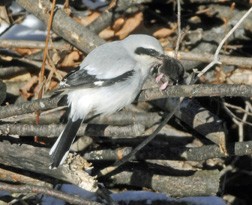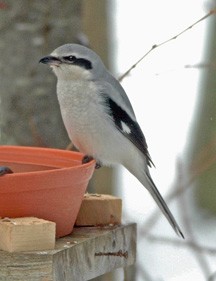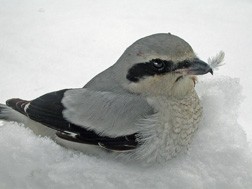Northern Shrike
- Share
- Tweet
- Pin
- Share
Two nearly totally unrelated bird species are on my mind this morning, the Scissor-tailed Flycatcher and the Northern Shrike. First off, I needed the date of my first sighting of a Northern Shrike to be included in this story and I was quite sure that it would be in my first Peterson Field Guide to the Birds.
That 1947 edition was bought in the spring of 1954 at a small bookstore in Lawton, Okla., while I was stationed with the U.S. Army Field Artillery at Fort Sill. The Scissor-tailed Flycatcher I had seen there Monday, May 10, 1954, while standing in “chow” line had stumped me, so that’s the reason a good field guide was needed. How fortunate it was that I kept dates of first sightings of birds opposite the proper pictures.
It was on Dec. 24, 1961 while helping John Kraupa, biology teacher at the Two Rivers High School, with their Christmas Bird Count that we had a wonderful look through my spotting scope of the Northern Shrike close to the Shoto Dam, slightly north of Manitowoc. That initial close sighting of this solitary creature was only one of perhaps fewer than two to three dozen of similar excellences to follow during the next 62 years.

This Northern Shrike has killed a Meadow Vole near the Lukes’ brush pile.
This black, gray and white Robin-sized bird is accurately referred to as a songbird of prey. In fact it is the only passerine (a generally smaller perching songbird) along with its close relative, the Loggerhead or Migrant Shrike, on this continent capable of killing other animals too large to be swallowed whole, such as a Chickadee, and still be able to tear it apart and make use of it as food. (A note on the Loggerhead Shrike: this native summer resident has become very uncommon throughout Wisconsin in recent years and is rarely if ever seen in Door County.)
Having heard from other bird banders who had handled Northern Shrikes, I decided to wear sturdy gloves whenever handling. A Shrike that had hit someone’s window, was temporarily stunned or in shock and incapable of flight, and was brought to me for help. I was always quite surprised at their incredibly strong bite and fairly sure that its hooked and very sharp upper mandible was going to go clear through my glove.
The grip with its feet onto my finger was about that of a Blue Jay. Their practice of impaling victims, such as a small rodent or a bird, onto the thorn of a locust or thornapple tree, or even a barbed wire fence, is said to occur due to their inability to satisfactorily hold their prey with feet only as they rip them apart with their beak.
A nickname of “butcher bird” supposedly began years ago in England, the thought being that the Shrike suspended its meal on a thorn much like a butcher would hang a carcass from a hook. Undoubtedly this “butcher bird” nickname, along with its habits, is enough to give some people the “willies” and they unhesitatingly shoot the legally protected bird. What these people fail to realize it that they, in a sense, hire someone else to do their dirty work, that the neatly wrapped beefsteak they bought at the store once hung on a hook too as part of a carcass.

Note the lighter color of the rear portion of this Northern Shrike’s lower bill.
These strongly colored birds of gray, black and white are known for their hawk-like features. They are not particularly fast fliers over long distances but can produce great bursts of speed when they are making their surprise attack from above on a mouse or bird. More than once we have seen the Shrike take after a small bird that had been on the ground below our feeders, and chase it directly at one of the large picture windows in the lower level of our home. Both would strike the window and invariably the small bird was killed instantly while the larger, heavier and stronger Shrike nearly always survived. On just one occasion the Shrike did strike the window hard enough to be temporarily stunned. That bird landed in the snow bank a few feet from the glass surface and offered me some good pictures until minutes later it came to and speedily flew away.
They could well be called insect or grasshopper shrikes during mild weather because about one-half of their diet then consists of large insects. Another quarter of their warm weather food is made up of mice, one of their favorites. Small birds, reptiles and amphibians round out their food supply.
If you are interested in locating a Northern Shrike, look for a Blue Jay-sized bird having a rather heavy hooked beak, black mask, large white wing patches, dark wings and tail, and a grayish body. It will be perched alone often at the tip of a tree or on a power line with its tail held horizontally. This predatory songbird has a habit of flicking its tail while perched, intently surveying the scene below most likely for small rodents. These birds are rather frequent visitors to farmyards where House Sparrows and European Starlings tend to be more numerous.
Experts call the Northern Shrike an aberrant songbird, deviating from what is normal, untrue to type. One physical feature that enables it to act like a typical bird of prey is its notched beak, referred to as a tooth-notch arrangement, which aids this totally carnivorous (only in winter) predator to quickly kill its prey and in ripping its victims apart.
By the way, a close look at its beak reveals that the rear portion of its lower mandible is pale in comparison to the entire upper mandible and the front portion of the lower which are black. For the first time ever, we saw in our yard a few weeks ago a Northern Shrike in its first-winter plumage, easily told by its light brown color.

The sharply hooked beak of the Northern Shrike is easily seen. Also note the fine barring on its chest feathers.
A treasured experience occurred one December day some years ago when a Dark-eyed Junco landed on the platform feeder in our front yard. It soon became apparent that the creature was deathly concerned about something within its sight, judging by how it crouched so low to the feeder and remained quite motionless. Its colors blended perfectly with the darker seeds.
Like a flash the object on its mind streaked into the small White Ash tree within 10 feet of the feeder and perched there bobbing its tail, true to form. If you ever saw a Junco “melt” right into its surroundings here was one. Obviously the Shrike didn’t see the Junco; otherwise, it would have been on it in an instant. The Shrike soon lost interest in the quiet and seemingly deserted feeding area and disappeared into the distant spruces.
Not once did our Junco friend lose its stone-like poise. Wanting to check on the Shrike’s whereabouts I ran outdoors to have a look, and it was only then that the Junco made a frenzied beeline for the distant woods and protection. The wily black-masked marauder had disappeared.
